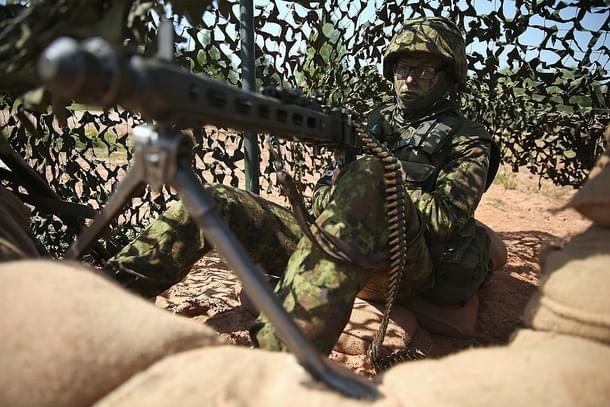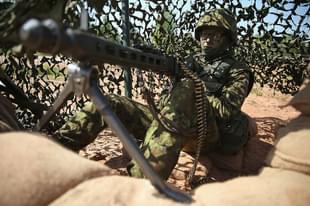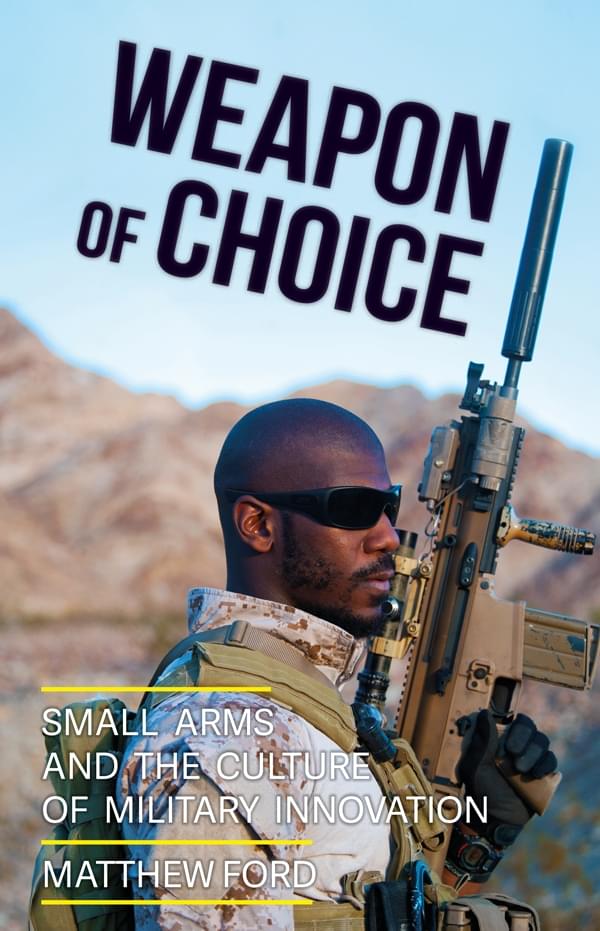Books
Ford’s ‘Weapon Of Choice’ Reveals How Social Factors Influence Military Innovation
Jaideep A Prabhu
Feb 04, 2017, 05:18 PM | Updated 05:18 PM IST
Save & read from anywhere!
Bookmark stories for easy access on any device or the Swarajya app.


Ford, Matthew. Weapon of Choice: Small Arms and the Culture of Military Innovation. London: C Hurst & Co Publishers, 2017. 256 pp.
The sheer complexity of modern military equipment has made it very difficult for the average person to understand the nuances of its design. This has inevitably invited a sense of technological determinism in most public conversations about military procurement, again, making the headlines only when expensive, high-end and alluring weapons such as fighter jets are involved. In this climate, Matthew Ford's Weapon of Choice: Small Arms and the Culture of Military Innovation is a welcome and much-needed reminder of how much social conditions influence technological choices. Focussing on the evolution of the rifle in Western – primarily British and American – militaries from 1900 to the present day, Ford uncovers a fascinating tapestry of weapons development involving soldiers, bureaucrats, scientists and engineers, and the politics of it all.
Weapon of Choice takes after the seminal work of Keith Grint and Steve Woolgar, The Machine at Work: Technology, Work and Organization, which challenges the notion that some inherent design property within a machine dictates the capacity of the technology and gives the device its eventual value. Instead, the desirability of certain design properties is shaped by the interaction of several variables, most of which are not technical. Grint and Woolgar themselves continue the path-breaking work of Donald Mackenzie, Inventing Accuracy: A Historical Sociology of Nuclear Missile Guidance, which argues for accuracy as a social process that can even be uninvented. Not only does such iconoclastic scholarship dispel the myth of technological momentum, it also opens the possibility of feedback from lower down the technical hierarchy – in other words, bottom-up history.
Ford organises his chapters by the different groups that have shaped the evolution of small arms. He starts with a hat-tip to epistemology and discusses the academic literature on the social shaping of technology. Various theoretical frameworks are analysed as the author moulds his own, and prepares the reader to understand the social contours of military innovation as these theories keep reappearing in later chapters. Readers will appreciate that the professional jargon has been kept to a minimum and the argument flows smoothly.
Ford begins the actual discussion on military innovation with the infantry. The design of a gun, we are informed, has always been a delicate balance between marksmanship, firepower, willpower, and stopping power. These choices reflect upon the the weight and cost of the rifle and the tactics of individual soldiers and units. As the various battlefields of the British empire yielded varied experiences, soldiers had different expectations from their weapons; standardisation across the army would not be easy.
While engineers struggled to accommodate the contradictory views of soldiers and the fixed, if old-fashioned, views of senior officers in defining the range of technical possibilities that would address the problems of the battlefield, scientists were locked in a debate about lethality. To the layman, this might seem simple: enough wounding capacity such that the fallen enemy would not stand up again. However, it was too easy to design weapons for overkill. The objective of the scientist was to design ammunition that had just enough power to kill, thereby making the most efficient use of national resources. It is not difficult to imagine the differences of opinion between countries here: those dependent on imported war material, such as Britain, designed frugally, while countries like the United States, which were not held back by such constraints, were less bothered with the new science.
This is not to say that the US planners did not understand the benefits of such considerations but merely that they did not necessarily feel compelled to adopt its principles. Although a rule of thumb had been accepted since the 1880s that the muzzle energy of a bullet should be 58 ft-lb or higher to cause death, there were long debates on the merits of kinetics versus calibre. Yet, given the different levels of vulnerability of various body parts and splintering of shells, killing remained at best a probabilistic calculation than an absolute one. Ford's skilful narration of the conundrums faced by the technicians passes their sense of frustration to the reader.

There have been entrenched bureaucracies in the war industry long before Dwight Eisenhower warned of the rise of a military-industrial complex. These exerted influence over their national governments to advance their military designs over those of foreign states and bureaucracies. Of course, such considerations were not merely about profits but also reflected their thinking on the philosophy of arms and ammunition. Weapon of Choice dwells on the tussle in NATO between the British EM-2, the American T65 and the Belgian FAL rifles in the early 1950s to show how far removed some of these debates could get from purely technical considerations. An important development at this juncture in history is the entry of scientists into policymaking as weapons became too complicated for policymakers to understand. Yet, treaty obligations, economics and other factors curtailed the power of the technical class to leave their imprint upon military procurement.
Ford makes the compelling argument that military innovation is not all about technology but also about cultural values. He shows that scientists cannot answer socio-technical questions reliably on their own, implying that decisions about technology are actually framed by cultural values. One particular strength of Weapon of Choice is that it looks at the entire spectrum along which choices can be made: from the politicians and bureaucracy at the top to the soldiers at the bottom, as well as scientists, engineers and senior officers from the middle out. This last group is Ford's unique and valuable contribution to the growing field of social history of technology. The conclusions, however, should leave the reader more worried about the veracity of technical claims and effectiveness of more expensive weapon systems being inducted into the military.
However, one wonders if too much is not being made of the social dimensions of technical choices. Any engineer should be able to understand that an optimal design may not necessarily be suitable given resource constraints and, keeping that in mind, the best sub-optimal weapon design can hardly be considered a sleight of hand in the technological narrative. The military is a social organism as is the political apparatus; decisions made therein are bound to reflect social norms and cultural values. Do these necessarily shape technical choices made in the midst of design? Probably not. Ford is absolutely correct that socio-cultural conditions and values affect our decisions about technologies adopted. Yet there remains a realm of the purely technical that, too, functions within the socio-cultural ultimately, but retains its purity of purpose. For Ford, that does not matter for it carries no social consequence.
One cannot help but wonder what would a similar work on the military-political complex of non-Western states look like? Would it have its own socio-cultural quirks? Or would the adoption of Western ideas of efficiency, time and space – modernity – be reflected? It is a pity that most such states do not afford the level of access Ford has enjoyed in researching his project.
Weapon of Choice is a refreshing look at how weapons are designed and inducted. It is well-written with something there for everybody – to the interested layman, Ford offers a new way of understanding military procurement; to the historian, Weapon of Choice adds the important middle to the top-down/bottom-up debate; and to the military man, there is much food for thought. There is no aspect of our activities that is not touched by our values; to essentialise certain strains may answer questions in a limited context but would ultimately paint an incomplete picture. Ford's Weapon of Choice is a thought-provoking and eminently readable book that should not be missed.
Disclaimer: The reviewer and the author of this book were fellows at West Point together.
Jaideep A. Prabhu is a specialist in foreign and nuclear policy; he also pokes his nose in energy and defence related matters.





